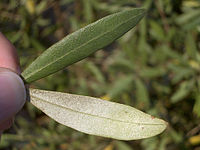- Olive leaf
-
Olive leaf is the leaf of the olive tree (Olea europaea). While olive oil is well known for its flavor and health benefits, the leaf has been used medicinally in various times and places. Natural olive leaf and olive leaf extracts (OLE), are now marketed as an anti-aging, immunostimulator and an antibiotic. Clinical evidence has proven the blood pressure lowering effects of carefully extracted olive leaf extracts.[1][2][3][4] Bioassays support its antibacterial, antifungal, and anti-inflammatory effects at a laboratory level. A liquid extract made directly from fresh olive leaves recently gained international attention when it was shown to have an antioxidant capacity almost double green tea extract and 400% higher than vitamin C.[5]
Contents
Active compounds
The primary medical constituents contained in unprocessed olive leaf is believed to be the antioxidants oleuropein and hydroxytyrosol, as well as several other polyphenols and flavonoids, including oleocanthal.
Nutritional and medicinal uses
Olive leaves and its extracts are used in the complementary and alternative medicine community for the presumed ability to act as a natural pathogens killer by inhibiting the replication process of many pathogens.[citation needed]
Olive leaf is commonly used to fight colds and flu, yeast infections, and viral infections such as the hard-to-treat Epstein-Barr disease, shingles and herpes. Olive leaf has been shown to reduce low-density lipoproteins (LDL), or bad cholesterol. Researchers[1][2][3][4] have found that olive leaf lowers blood pressure and increases blood flow by relaxing the arteries.[4]
Recent research has shown that olive leaf extracts may reduce infarct volume, brain edema, blood-brain barrier permeability, and improve neurological deficit scores after transient middle cerebral artery occlusion (stroke).[6]
Olive leaf harbours antioxidant properties that help protect the body from the continuous activity of free radicals.[2][5][7][8][9][10][11] Free radicals are highly reactive chemical substances that, when oxidized, can cause cellular damage if left unchecked. Some recent research on the olive leaf has shown its antioxidants to be effective in treating some tumors and cancers such as liver, prostate, colon, skin and breast cancer, clinical studies lacking, Olive leaf is especially potent when used in combination with other antioxidants.[12][13][14][15] available on [1]
Olive leaf can be taken as a liquid concentrate, dried leaf tea, powder, or capsule. The leaf extracts can be taken in powder, liquid concentrate, or capsule form though the fresh-picked leaf liquid extracts are quickly gaining popularity due to the broader range of healing compounds they contain.
Soaps and cosmetics
Olive leaf extracts are combined with olive oil in soaps and skin creams for application to the skin or other body surfaces.
References
- "Olive leaf extract exhibits antiviral activity against viral haemorrhagic septicaemia rhabdovirus (VHSV)"
- [2]
"Induction of Growth Inhibition and Differentiation of Human Leukemia HL-60 Cells by a Tunisian Gerboui Olive Leaf Extract"
- [3] "Olea europaea: A Phyto-Pharmacological Review [4]
- Information on olive leaf tea
- ^ a b Perrinjaquet-Moccetti et al. Food Supplementation with an Olive (Olea europaea L.) Leaf Extract Reduces Blood Pressure in Borderline Hypertensive Monozygotic Twins, 2008.
- ^ a b c Somova et al. Antihypertensive, antiatherosclerotic and antioxidant activity of triterpenoids isolated from Olea europaea, subspecies africana leaves, 2003.
- ^ a b Khayyal et al. Blood pressure lowering effect of an olive leaf extract (Olea europaea) in L-NAME induced hypertension in rats, 2002.
- ^ a b c Zarzuelo et al. Vasodilator effect of olive leaf, 1991.
- ^ a b Dr Stevenson, L,. et al. Oxygen Radical Absorbance Capacity (ORAC) Report on Olive Leaf Australia's Olive Leaf Extracts, Southern Cross University, 2005.
- ^ Mohagheghi et al. The neuroprotective effect of olive leaf extract is related to improved blood-brain barrier permeability and brain edema in rat with experimental focal cerebral ischemia, 2011.
- ^ Saija et al. In vitro evaluation of the antioxidant activity and biomembrane interaction of the plant phenols oleuropein and hydroxytyrosol, 1998.
- ^ Briante et al. Olea europaea L. leaf extract and derivatives: antioxidant properties, 2002.
- ^ Speroni et al. Oleuropein Evaluated In Vitro and In Vivo as an Antioxidant, 1998.
- ^ Pinelli et al. Quali-quantitative analysis and antioxidant activity of different polyphenolic extracts from Olea europea L. leaves, 2000.
- ^ Hamdi et al. Oleuropein, a non-toxic olive iridoid, is an anti-tumor agent and cytoskeleton disruptor, 2005.
- ^ Dr Stevenson, L,. et al. In vitro Biological Activities of Pure Olive Leaf Extract & High Strength Olive Leaf Extract, 2006.
- ^ Olive Leaf, Top 10 Immune System Boosters published by GAYOT.com
- ^ Muneer Abuismail. Analysis and Biological Evaluation of Jordanian Olive Trees Leaves - Cancer Cure Invention With Tissue Repair Potential, 2011.
Olives Olive cultivars - Aglandau
- Arbequina
- Bosana
- Bouteillan
- Cailletier
- Cayon
- Germaine
- Grossane
- Hojiblanca
- Kalamata
- Lucques
- Olivière
- Picholine
- Sabine
- Salonenque
- Tanche
Other topics - Olive
- Olive oil
- Olive leaf
- Orujo (olive waste)
Categories:- Olives
- Medicinal plants
- Leaves
Wikimedia Foundation. 2010.

